#Capital from Rome to Byzantium
Explore tagged Tumblr posts
Text
The Kingdom of Lysara
Additional information to my ongoing (and newly started) fanfiction: The Dove and the masked king! ❤
🌄 The Kingdom of Lysara
❄️ Location & Geography
Region: Bordering the northeastern frontier of the Kingdom of Jerusalem—tucked between the eastern edge of the Crusader States and the beginning of Mesopotamian trade routes. Think of it as a lush valley nestled between dry, rocky mountains and fertile lowlands.
Climate: A mix of Mediterranean and highland—warm, golden summers, but winters can bring snow to the higher elevations like the capital city. Cool breezes roll off the mountains year-round. Ideal for rare herbs, mountain olives, and cool-weather vineyards.
Capital City: Velaneth, built on a series of terraces around a crystalline lake. White-stone towers, blue tile rooftops, and vertical gardens spilling down the palace walls. Visually distinct from Jerusalem's sand-colored architecture.
🗿Culture & Society
Customs: Still focused on duty, honor, and balance. Women are taught both diplomacy and the basics of combat. Noble children are educated in multiple languages and the history of empires, including Rome and Byzantium.
Military: Still renowned for precision and psychological warfare. The Ashen Guard remains feared and elite, with Elyan (the second prince) as their current commander.
Marriage Practices: Noble marriages are political, not personal. Love is rare, and arranged alliances are sacred contracts. Your character would be expected to accept such a match, but her heart might be more rebellious than her upbringing allows.
🕊 Religion
The Old Faith – The Veiled Flame: Still practiced by the majority of the older and noble class. Worship centers around fire, inner strength, and silence. Rituals involve veils, candles, and symbolic purification by flame.
Christian Influence: In recent decades, Christian missionaries and pilgrims traveling through Lysara have inspired a slow religious shift, particularly in the southern valleys and among younger generations. Churches have begun appearing in larger towns, and debates over faith are common at court.
Amicia is caught between both—raised with reverence for the Veiled Flame, but increasingly drawn to the gentleness and forgiveness in Christianity. She's read parts of the Gospels, speaks Latin fluently, and sometimes sneaks into Christian chapels while traveling.
🤴Government
Structure: A monarchy ruled by the Council of Flame—an advisory body made of generals, high-priests, and scholars. While the monarch makes final decisions, their strength lies in how well they balance the council’s often conflicting voices.
Current Ruler: The aging King Alaric III, father of three. His health is failing, which means he wants to conclude his business before his son Maeron takes over. This includes marrying Amicia off to King Baldwin VI. of Jerusalem to strengthen Lysara before his passing.
⭐️Lysara’s Symbolism & Style
Sigil: A silver phoenix rising from a dark mountain, wings outstretched, surrounded by a ring of fire.
Colors: Deep indigo, silver, and crimson.
Clothing: Elegant and layered—high collars, embroidery that tells lineage stories, and lightweight armor beneath ceremonial robes. Veils or half-masks are worn in formal settings by both genders
👑 Royal Family & Government
King Alaric III: A seasoned ruler in his late 50s, known for his military mind and pragmatic diplomacy. Loyal to tradition but aware of shifting tides in the region.
His Children:
Prince Maeron (eldest son): Heir to the throne, groomed for leadership, deeply committed to Lysaran tradition.
Prince Elyan (second son): A military commander and head of the Ashen Guard, the kingdom's elite fighters. When he was a child he was often very sick, something that follows him into adulthood. Amicia always stayed by his side and he is also her favourite brother.
Princess Amicia: Youngest of the royal siblings. Raised to serve her family through marriage or alliance. She's sharp, observant, and carries herself with quiet strength, even if she's not in line for the throne.
7 notes
·
View notes
Text
If you think the Roman Empire fell in 476 AD, I'm here to tell you: No, it didn't!
The Metropolitan Museum of Art summarizes the history of the Roman Empire! This explains why Greeks called themselves Romans till the 19th century!

transcript: In 330 A.D., the first Christian ruler of the Roman empire, Constantine the Great (r. 306–337) (26.229), transferred the ancient imperial capital from Rome to the city of Byzantion located on the easternmost territory of the European continent, at a major intersection of east-west trade. The emperor renamed this ancient port city Constantinople (“the city of Constantine”) in his own honor (detail, 17.190.1673–1712); it was also called the “New Rome,” owing to the city’s new status as political capital of the Roman empire. The Christian, ultimately Greek-speaking state ruled from that city would come to be called Byzantium by modern historians, although the empire’s medieval citizens described themselves as “Rhomaioi,” Romans, and considered themselves the inheritors of the ancient Roman empire.
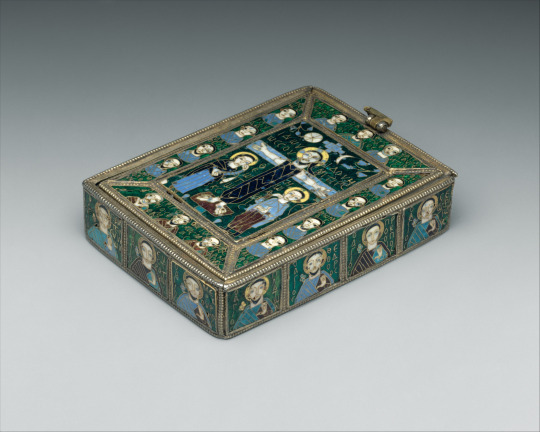


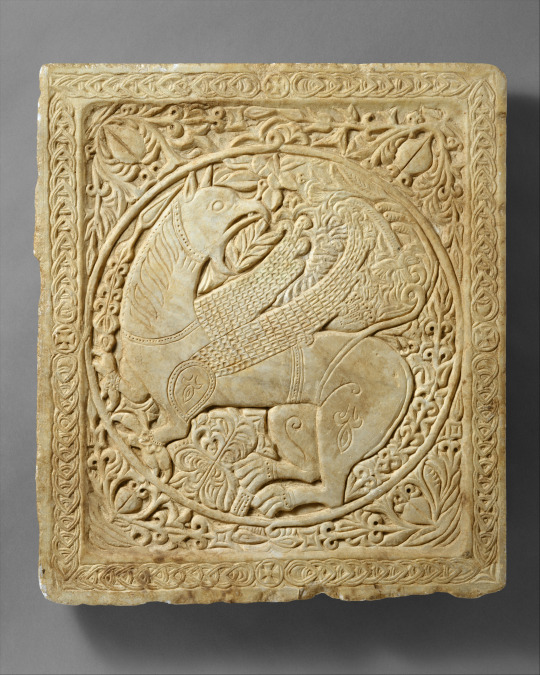
30 notes
·
View notes
Text
Saints&Reading: Saturday, January 13, 2024
Leavetaking (apodosis) of the Nativity of Christ
december 31_ january 13
MARTYR ZOTICUS OF CONSTANTINOPLE, FEEDER OF ORPHANS (4TH C.)
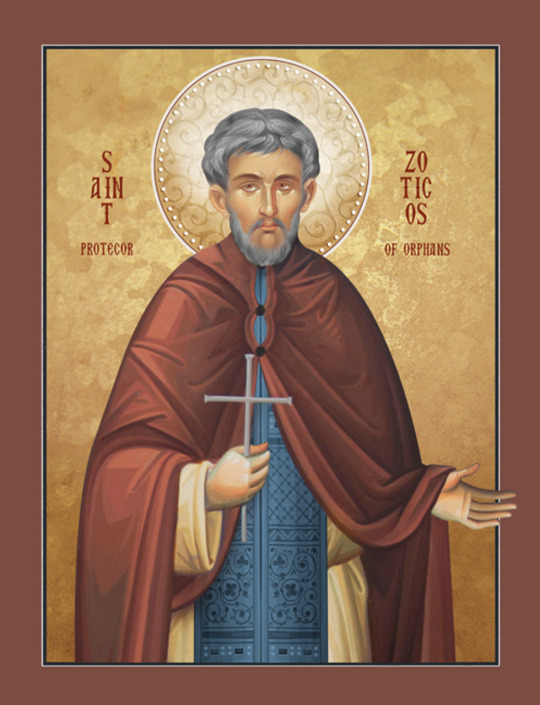
Icon from Uncut mountain suppy
He was born in Rome, and as a young man was chosen by the Emperor Constantine to assist in the foundation of his new capital at Byzantium. An outbreak of leprosy in the new City became so severe that the Emperor ordered that all lepers, whatever their rank, be driven from the city or drowned in the sea. Zoticus, moved by compassion for these people, went to the Emperor and asked him for a large amount of gold to buy gems and pearls to enhance the glory of the city, 'For, as Your Majesty knows, I am well-qualified in this field.' The Saint then used the gold to ransom all those being led into exile or to drowning, and to establish for them a camp on the hill of Olivet on the opposite shore of the Bosphorus. There he brought the sick and provided for their care. In 337 Constantius, an Arian heretic, took the throne upon the death of his father. Some of Zoticus' enemies at court, seeing an opportunity, denounced Zoticus to the new Emperor, saying that he not only held subversive views, but had misappropriated public money. When he learned of these charges, Zoticus presented himself to the Emperor, finely dressed, and offered to take Constantius to see the gems and pearls that he had bought on his behalf. When they reached the hill of Olivet, Constantius was astonished to see a company of lepers coming to greet him with lighted candles, honoring and praising him and their patron Zoticus. Then the holy Zoticus said to the Emperor, 'These are the precious stones and brilliant pearls that give luster to the crown of the heavenly Kingdom that you will inherit by their prayers. I bought them for the salvation of your soul.'Instead of being grateful, the heartless Emperor ordered that Zoticus be tied behind wild mules and dragged until dead. The mules ran down the hill, breaking the Saint's body upon the rocks an brush. Then, of their own accord, they returned to the top of the hill, still dragging the body, and, like Balaam's ass (Numbers ch. 22), spoke and proclaimed that the Martyr must be buried on that hill. The astonished and repentant Emperor ordered the Martyr buried with honor, and commanded that a hospital for lepers be built there, staffed by the best physicians and caretakers. Saint Zoticus is also called Orphanotrophos, 'Cherisher of Orphans,' because in later years a large orphanage was added to the leprosarium. The orphanage included a general hospital and a home for the aged. The Saint was honored throughout Byzantine history as the patron of the orphanage.
VENERABLE MELANIA THE YOUNGER, NUN OF ROME(439)
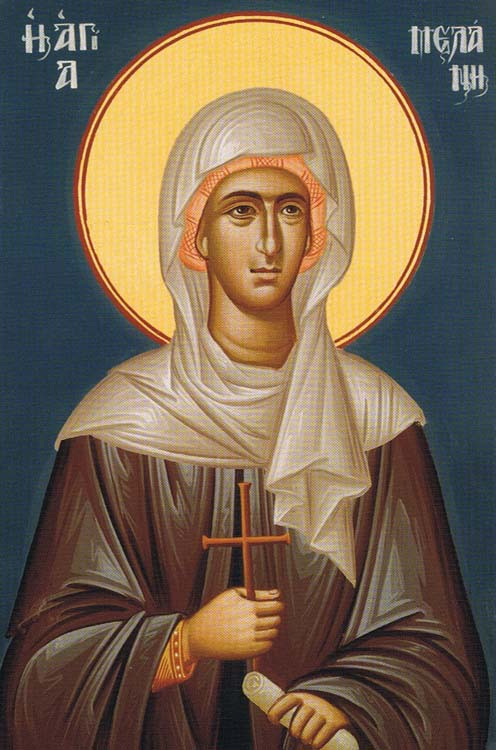
Saint Melania was born in Rome into a devout Christian family. Her parents, people of property and wealth, hoped that their daughter would marry and have children who would inherit their wealth.
At fourteen years of age Melania was married to the illustrious youth Apinianus. From the very beginning of their married life, Saint Melania asked her husband to live with her in chastity or else release her from the marriage. Apinianus answered, “I cannot agree to this right now. When we have two children to inherit the property, then we shall both renounce the world.”
Soon Melania gave birth to a daughter, whom the young parents dedicated to God. Continuing to live together in marriage, Melania secretly wore a hair shirt and spent her nights in prayer. The second child, a boy, was premature and had severe complications. They baptized him, and he departed to the Lord.
Seeing the suffering of his wife, Apinianus asked the Lord to preserve Saint Melania’s life, and he vowed to spend the rest of their life together in chastity. Recovering, Saint Melania stopped wearing her beautiful clothing and jewelry. Soon their daughter also died. The parents of Saint Melania did not support the young couple’s desire to devote themselves to God. It was only when Saint Melania’s father became deathly ill, that he asked their forgiveness and permitted them to follow their chosen path, asking them to pray for him.
The saints then left the city of Rome, and began a new life completely dedicated to the service of God. Apinianus at this time was twenty-four years of age, and Melania twenty. They began to visit the sick, to take in wanderers, and to help the indigent. They visited those who were exiled, and mine-convicts, and the destitute, there in debtor’s prison. After selling their estates in Italy and Spain, they generously helped monasteries, hospitals, widows and orphans in Mesopotamia, Syria, Egypt, Phoenicia, and Palestine.
Many churches and hospitals were built with their assistance. Churches of both West and East benefited from them. Leaving their native land, they set sail for Africa, and a strong storm arose while they were at sea. The sailors said that this was because of the wrath of God, but Saint Melania said that it was not God’s will that they should go directly to their destination.
The waves carried the ship to an island on which barbarians had landed. The besiegers demanded a ransom from the inhabitants, or else they threatened to lay waste the city. The saints supplied the necessary ransom, and thus saved the city and its people from destruction.
Resuming their voyage, they landed in Africa and helped all the needy there. With the blessing of the local bishops, they made offerings to churches and monasteries. During this time Saint Melania continued to humble her flesh by strict fasting, and she fortified her soul by constantly reading the Word of God, making copies of the sacred books and distributing them to those who lacked them. She sewed a hairshirt for herself, put it on, and continued to wear it.
The saints spent seven years in Carthage, and then decided to visit Jerusalem. At Alexandria, they were welcomed by the bishop, Saint Cyril, and they met in church with the holy Elder Nestorius, who was possessed of the gift of prophecy and healing. The Elder turned to them and told them to have courage and patience in expectation of the Glory of Heaven.
At Jerusalem, the saints distributed their remaining gold to the destitute and then spent their days in poverty and prayer. After a short visit to Egypt, where the saints visited many of the desert Fathers, Saint Melania secluded herself in a cell on the Mount of Olives. Only occasionally did she see Saint Apinianus.
Later, she founded a monastery, where eventually ninety virgins lived in obedience to Saint Melania. Out of humility, she would not consent to be abbess, and lived and prayed in solitude as before. In her instructions, Saint Melania urged the sisters to be vigilant and to pray, to disdain their own opinions and cultivate first of all love for God and for one another, to keep the holy Orthodox Faith, and to guard their purity of soul and of body.
In particular, she exhorted them to be obedient to the will of God. Calling to mind the words of the Apostle Paul, she counselled them to keep the fasts “not with wailing, nor from compulsion, but in virtuous disposition with love for God”. By her efforts an oratory and altar were built in the monastery, where they enshrined the relics of saints: the Prophet Zachariah, the holy Protomartyr Stephen, and the Forty Martyrs of Sebaste. About this time Saint Apinianus fell asleep in the Lord. Saint Melania buried his relics and there spent another four years in fasting and unceasing prayer.
Saint Melania wanted to build a men’s monastery on the Mount of the Ascension of the Lord. The Lord blessed her intent by sending a benefactor who provided the means for the monastery. Joyfully accepting it, Saint Melania finished the great work in a single year. In this monastery, saintly men began to lift up unceasing prayer in the church of the Ascension of Christ.
Having completed her tasks, the saint left Jerusalem for Constantinople, hoping to save the soul of her pagan uncle Volusianus who had traveled there from Rome. Along the way she prayed at the relics of Saint Laurence (August 10), at the place of his martyrdom, and received auspicious signs. Arriving in Constantinople, the saint found her uncle had fallen ill. Her demeanor and her inspired discourses had a profound influence on the sick man. He gave up pagan impiety and died a Christian.
During this time many inhabitants of the capital were deceived by the heretical teaching of Nestorius. Saint Melania accepted anyone who turned to her for proper explanation, converting many of them to Orthodoxy. Many miracles were worked through the prayers of the saint.
Returning to her own monastery, the saint sensed the approach of death, and told this to the priest and the sisters. They listened to her final instructions with deep sorrow and with tears. Having asked their prayers and commanding them to preserve themselves in purity, she received the Holy Mysteries with joy. Saint Melania peacefully gave up her soul to the Lord in the year 439.
Source: Orthodox Church in America_OCA

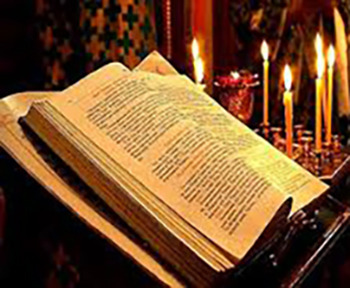
1 THESSALONIANS 5:14-23
14 Now we exhort you, brethren, warn those who are unruly, comfort the fainthearted, uphold the weak, be patient with all. 15 See that no one renders evil for evil to anyone, but always pursue what is good both for yourselves and for all. 16 Rejoice always, 17 pray without ceasing, 18 in everything give thanks; for this is the will of God in Christ Jesus for you. 19 Do not quench the Spirit. 20 Do not despise prophecies. 21 Test all things; hold fast what is good. 22 Abstain from every form of evil. 23 Now may the God of peace Himself sanctify you completely; and may your whole spirit, soul, and body be preserved blameless at the coming of our Lord Jesus Christ.
LUKE 17:3-10
3 Take heed to yourselves. If your brother sins against you, rebuke him; and if he repents, forgive him. 4 And if he sins against you seven times in a day, and seven times in a day returns to you, saying, 'I repent,' you shall forgive him. 5 And the apostles said to the Lord, "Increase our faith." 6 So the Lord said, "If you have faith as a mustard seed, you can say to this mulberry tree, 'Be pulled up by the roots and be planted in the sea,' and it would obey you. 7 And which of you, having a servant plowing or tending sheep, will say to him when he has come in from the field, 'Come at once and sit down to eat'? 8 But will he not rather say to him, 'Prepare something for my supper, and gird yourself and serve me till I have eaten and drunk, and afterward you will eat and drink'? 9 Does he thank that servant because he did the things that were commanded him? I think not. 10 So likewise you, when you have done all those things which you are commanded, say, 'We are unprofitable servants. We have done what was our duty to do.'
#orthodoxy#orthodoxchristianity#easternorthodoxchurch#originofchristianity#spirituality#holyscriptures#gospel#bible#wisdom#saints
6 notes
·
View notes
Text
Events 5.11
330 – Constantine the Great dedicates the much-expanded and rebuilt city of Byzantium, changing its name to New Rome and declaring it the new capital of the Eastern Roman Empire. 868 – A copy of the Diamond Sūtra is published, making it the earliest dated and printed book known. 973 – In the first coronation ceremony ever held for an English monarch, Edgar the Peaceful is crowned King of England, having ruled since 959 AD. His wife, Ælfthryth, is crowned queen, the first recorded coronation for a Queen of England. 1068 – Matilda of Flanders, wife of William the Conqueror, is crowned Queen of England. 1258 – Louis IX of France and James I of Aragon sign the Treaty of Corbeil, renouncing claims of feudal overlordship in one another's territories and separating the House of Barcelona from the politics of France. 1713 – Great Northern War: After losing the Battle of Helsinki to the Russians, the Swedish and Finnish troops burn the entire city, so that it would not remain intact in the hands of the Russians. 1812 – Prime Minister Spencer Perceval is assassinated by John Bellingham in the lobby of the British House of Commons. 1813 – William Lawson, Gregory Blaxland and William Wentworth discover a route across the Blue Mountains, opening up inland Australia to settlement. 1857 – Indian Rebellion of 1857: Indian rebels seize Delhi from the British. 1880 – Seven people are killed in the Mussel Slough Tragedy, a gun battle in California. 1889 – An attack upon a U.S. Army paymaster and escort results in the theft of over $28,000 and the award of two Medals of Honor. 1894 – Four thousand Pullman Palace Car Company workers go on a wildcat strike. 1919 – Uruguay becomes a signatory to the Buenos Aires copyright treaty. 1970 – The 1970 Lubbock tornado kills 26 and causes $250 million in damage. 1985 – Fifty-six spectators die and more than 200 are injured in the Bradford City stadium fire. 1996 – After the aircraft's departure from Miami, a fire started by improperly handled chemical oxygen generators in the cargo hold of Atlanta-bound ValuJet Airlines Flight 592 causes the Douglas DC-9 to crash in the Florida Everglades, killing all 110 on board. 1997 – Deep Blue, a chess-playing supercomputer, defeats Garry Kasparov in the last game of the rematch, becoming the first computer to beat a world-champion chess player in a classic match format. 1998 – India conducts three underground atomic tests in Pokhran. 2011 – An earthquake of magnitude 5.1 hits Lorca, Spain. 2013 – Fifty-two people are killed in a bombing in Reyhanlı, Turkey. 2014 – Fifteen people are killed and 46 injured in Kinshasa, DRC, in a stampede caused by tear gas being thrown into soccer stands by police officers. 2016 – One hundred and ten people are killed in an ISIL bombing in Baghdad. 2022 – The Burmese military executes at least 37 villagers during the Mon Taing Pin massacre in Sagaing, Myanmar. 2024 - Minnesota officially updates its flag.
2 notes
·
View notes
Text


Istanbul, Türkiye🇹🇷
Istanbul was historically known as Byzantium and later Constantinople. It is a city where Europe connects Asia, or West connects East, blending diverse cultural and architectural influences from its days as the heart of three great empires: Roman, Byzantine and Ottoman.


Istanbul was historically known as Byzantium and later Constantinople. It is a city where Europe connects Asia, or West connects East, blending diverse cultural and architectural influences from its days as the heart of three great empires: Roman, Byzantine and Ottoman.

Founded around 660 BCE, it became a cultural and political capital in 330 CE under Emperor Constantine the great, who established it as the new Rome. The city flourished under Byzantine rule, with masterpieces like the Hagia Sophia, which became an architectural marvel of the Christian world.

When Fatih Sultan Mehmed II conquered Constantinople in 1453, it marked the end of the 1,123-year-old Byzantine Empire and the beginning of Istanbul’s Ottoman era. The Ottomans transformed the city, adding iconic structures like the Topkapi Palace, the grand Blue Mosque and Suleymaniye Mosque, a work of the famed architect Mimar Sinan. Sinan, regarded as one of the greatest architects in Ottoman history, shaped the skyline with his unique blend of Islamic and Byzantine influences.
Istanbul’s Grand Bazaar and Spice Bazaar reflect its role as a major trade center, where East met West. Even today, Istanbul is celebrated for its vibrant bazaars, cultural festivals and historical landmarks, a living museum of civilizations that shaped its legacy.

1 note
·
View note
Video
youtube
Majestic Istanbul: From Byzantium to Modern Day!
Foundation and Early History: Byzantium: The city was originally founded as Byzantium by Greek colonists from Megara around 657 BCE. It was strategically located on the European side of the Bosporus Strait, which made it a significant trade and military hub. Roman Conquest: Byzantium came under Roman control in 196 CE after Emperor Septimius Severus besieged and captured the city. Constantine the Great and Constantinople: Foundation of Constantinople: In 330 CE, Roman Emperor Constantine the Great founded the city as Nova Roma (New Rome), but it soon became known as Constantinople, after Constantine. He aimed to create a new capital for the Roman Empire that was strategically located and better protected than Rome. Growth and Development: Constantine and his successors invested heavily in the city's infrastructure, including the construction of walls, forums, and significant buildings like the Hagia Sophia, initially built by Constantine and later expanded. Byzantine Era Height of the Byzantine Empire: Capital of the Byzantine Empire: Constantinople became the capital of the Byzantine Empire, the Eastern Roman Empire, and a center of Orthodox Christianity. Architectural and Cultural Flourishing: During the reign of Justinian I (527-565 CE), the city saw substantial architectural and cultural development. The most notable project was the reconstruction of the Hagia Sophia, which became a symbol of Byzantine architectural brilliance. Challenges and Resilience: Sieges and Invasions: Constantinople withstood multiple sieges over the centuries, including attacks by Persian, Arab, and Bulgarian forces. The city's formidable defensive walls, especially the Theodosian Walls, were crucial in repelling invaders. Fourth Crusade: In 1204, Constantinople was sacked by Crusaders during the Fourth Crusade, leading to a period of Latin rule known as the Latin Empire (1204-1261). The Byzantines recaptured the city in 1261 under Michael VIII Palaiologos. Ottoman Era Ottoman Conquest: Fall of Constantinople: On May 29, 1453, Sultan Mehmed II of the Ottoman Empire successfully captured Constantinople after a 53-day siege. This event marked the end of the Byzantine Empire and a significant shift in world history. Transformation and Development under Ottoman Rule: Renaming and Reconstruction: The city was renamed Istanbul, although the name Constantinople remained in use for many years in the West. Mehmed II initiated major reconstruction efforts, including the conversion of the Hagia Sophia into a mosque. Cultural and Economic Hub: Istanbul became the capital of the Ottoman Empire and one of the most significant cities in the world. It was a melting pot of cultures and a critical center for trade, culture, and politics. Architectural Renaissance: The Ottomans endowed the city with numerous architectural masterpieces, such as the Blue Mosque (Sultan Ahmed Mosque), Topkapi Palace, and the Suleymaniye Mosque, designed by the famed architect Mimar Sinan. Modern Era End of the Ottoman Empire: Early 20th Century: The decline of the Ottoman Empire in the late 19th and early 20th centuries culminated in its dissolution after World War I. Republic of Turkey: Following the war, the Republic of Turkey was established in 1923 by Mustafa Kemal Atatürk, and Ankara was chosen as the new capital. However, Istanbul remained Turkey's cultural and economic heart. Conclusion Istanbul's history as Byzantium, Constantinople, and Istanbul reflects its transformation from a Greek colony to a major Roman city, the heart of the Byzantine Empire, and finally a central city in the Ottoman Empire. Each era contributed layers of cultural, architectural, and historical richness that make Istanbul a unique and enduring metropolis.
0 notes
Text
Also, unless I've butchered the names... Wasn't the Byzantine empire and Holy Roman empire two different empires?
I mean... Yes, the Byzantine empire had been called the Roman empire at the time, because it's the Roman empire after they moved the capital from Rome to Istanbul (then Byzantium, afterwards named Constantinople after the guy who moved the capital). The Holy Roman Empire was... A different entity...
I’m going to Constantinople, that shit better not be Istanbul
56K notes
·
View notes
Text
How Constantinople, the“New Rome”, was dedicated to the Mother of God
On learning of the tyrannical measures taken by the Roman emperor Maximinus II Daza in the East against the Christians, Constantine raised a powerful army, guided by the sign of the victorious Cross, and, during a campaign against the barbarians in Pannonia (1), penetrated Licinius' territory (2) in 322.
After an initial defeat at Andrinople, the tyrant retreated to Byzantium, before being definitively defeated at the battle of Chrysopolis on September 18, 324. The victorious Constantine, in the name of Christ and Truth, set about offering the reunited Roman Empire to the King of kings, and, like a new Apostle, proclaimed faith in the one God and in His Son incarnate for our salvation to the farthest reaches of East and West, from Mesopotamia to Great Britain. In an edict proclaimed throughout the Empire, he declared that God alone was to be considered the cause of his victories, and that he had been chosen by Providence to place himself at the service of good and truth. He urged all his subjects to follow his example, but without coercing anyone.
To this new Christian empire, which was to last a thousand years, Constantine decided to give a new capital, and inspired by a divine sign, the pious emperor fixed his choice on the small city of Byzantium, which occupied a pivotal position between East and West. He himself marked the boundaries of the new city, and instructed the master builder, Euphrata, to spare no expense in endowing it with monuments and public thoroughfares surpassing all other cities in the world in glory and magnificence.
When the city was founded on November 8, 324, Byzantium was named Constantinople and New Rome, and was subsequently dedicated to the Mother of God. Work was carried out with great haste, and on August 11, 330, the twenty-fifth anniversary of the emperor's reign, the inauguration of the new capital was celebrated with great pomp.
Source: Adapted from www.orthodoxie.com
Pannonia is an ancient region of Central Europe, straddling present-day Austria, Hungary, Slovenia, Croatia, north-western Serbia and northern Bosnia-Herzegovina. Licinius was Roman emperor from 308 to 324. For most of his reign, he was the colleague and rival of Constantine I
Hail, Mary, full of grace, the Lord is with you; blessed are you among women, and blessed is the fruit of your womb, Jesus. Holy Mary, Mother of God, pray for us sinners now and at the hour of our death. Amen.
0 notes
Text
Car Hire in Larnaca: Your Key to a Perfect Cyprus Road Trip

Introduction
Embarking on a road trip through Cyprus offers a unique and enriching experience that combines stunning landscapes, rich history, and vibrant culture. Starting your journey in Larnaca car hire company, a city brimming with charm and convenience, ensures you make the most of your adventure.
Larnaca Car hire not only provides the freedom to explore at your own pace but also allows you to discover hidden gems and off-the-beaten-path destinations. In this comprehensive guide, we’ll delve into everything you need to know about planning the perfect Cyprus road trip, starting with car hire in Larnaca.
Geographical Information
Location of Larnaca
Larnaca is a city on the southern coast of Cyprus, renowned for its beautiful beaches and historical sites. It’s strategically located, making it an excellent starting point for exploring the island. Situated about 40 kilometers from Nicosia, the capital of Cyprus, Larnaca offers easy access to various parts of the island.
Climate and Best Times to Visit
Cyprus enjoys a Mediterranean climate with hot, dry summers and mild, wet winters. The best times to visit are during the spring (April to June) and autumn (September to November) when the weather is pleasant, and the tourist crowds are thinner. These periods are perfect for sightseeing, beach activities, and exploring the countryside.
Overview of Cyprus Geography
Cyprus is the third largest island in the Mediterranean, characterized by its diverse landscapes, including stunning coastlines, rugged mountains, and fertile plains. The Troodos Mountains in the center of the island are a highlight, offering picturesque villages and nature trails. Coastal areas, especially around Larnaca, are known for their sandy beaches and clear waters.
Cultural Insights
Local Customs and Traditions
Cypriot culture is a blend of Greek and Middle Eastern influences, reflected in its customs, traditions, and hospitality. Visitors are often greeted with warmth, and it’s customary to offer a drink or small snack to guests. Festivals play a significant role in Cypriot life, with events like Easter and the Wine Festival in Limassol showcasing local traditions.
Cyprus’s Rich Cultural Heritage
Cyprus boasts a rich cultural heritage, with influences from ancient Greece, Rome, Byzantium, and the Ottoman Empire. This heritage is visible in the island’s architecture, archaeological sites, and art. The island is also known for its traditional music and dance, which are integral to local celebrations.
Important Cultural Festivals and Events
Cyprus hosts numerous cultural festivals throughout the year. The Kataklysmos Festival in Larnaca celebrates the biblical flood with water-based activities and events. The Kypria International Festival features performances by local and international artists, highlighting Cyprus’s cultural diversity. These festivals provide visitors with an immersive experience of Cypriot culture.
Must-Visit Attractions
Larnaca Salt Lake and Hala Sultan Tekke
One of Larnaca’s most iconic sites, the Larnaca Salt Lake, is a haven for birdwatchers, especially during the winter when flocks of flamingos visit. Nearby, the Hala Sultan Tekke, a revered Muslim shrine, offers a glimpse into the island’s religious history and provides a serene spot for reflection.
Finikoudes Beach and Promenade
The bustling Finikoudes Beach and Promenade are perfect for a leisurely stroll, sunbathing, or enjoying the vibrant nightlife. The area is lined with cafes, restaurants, and shops, making it a hub of activity both day and night.
Ancient Kition and the Larnaca Castle
History enthusiasts will appreciate a visit to Ancient Kition, an archaeological site that dates back to the 13th century BC. The Larnaca Castle, located at the edge of the Finikoudes Promenade, offers panoramic views of the city and the sea, and houses a small museum with medieval artifacts.
Activities and Experiences
Watersports and Beach Activities
Larnaca’s beaches offer a plethora of watersports, including windsurfing, jet skiing, and parasailing. The calm, clear waters are ideal for swimming and snorkeling, making it a haven for beach lovers and adventure seekers alike.
Hiking and Nature Trails
For those who enjoy the great outdoors, Cyprus car rental offers numerous hiking and nature trails. The Cape Greco National Forest Park, located a short drive from Larnaca, features trails that offer breathtaking coastal views and unique rock formations.
Exploring Local Markets and Shopping
Larnaca’s markets are a treasure trove of local produce, crafts, and souvenirs. The Larnaca Municipal Market, held regularly, is an excellent place to experience local life and pick up fresh fruits, vegetables, and handmade goods.
Travel Tips
Accommodation Options in Larnaca
Larnaca boasts a wide range of accommodation options, from luxury hotels and resorts to budget-friendly hostels and guesthouses. The Finikoudes area is particularly popular for its proximity to the beach and nightlife, while the Larnaca Marina area offers stunning sea views.
Best Larnaca Car Hire Services
Hiring a car in Larnaca is straightforward, with numerous reputable Larnaca car hire services available. Companies like Sixt, Europcar, and local providers offer a range of vehicles to suit different needs and budgets. It’s advisable to book in advance, especially during peak tourist seasons.
Essential Packing Tips for a Cyprus Road Trip
Packing for a Cyprus road trip requires some essentials: comfortable clothing and footwear for exploring, swimwear, sun protection (hats, sunscreen, sunglasses), and a good travel guide or map. Don’t forget your driver’s license and any necessary travel documents.
Navigating the Roads and Driving Tips
Driving in Cyprus is on the left-hand side, and road signs are in both Greek and English. The island’s roads are generally in good condition, but rural areas may have narrower and winding roads. GPS navigation or a reliable map is recommended for easy navigation.
Local Etiquette and Language Tips
While English is widely spoken in tourist areas, learning a few basic Greek phrases can enhance your travel experience. Simple greetings like “Kalimera” (Good morning) and “Efharisto” (Thank you) are appreciated. Respect for local customs and dress codes, especially in religious sites, is important.
Safety and Health Precautions
Road Safety and Driving Regulations
Cyprus has strict road safety laws, including mandatory seat belts and zero tolerance for drinking and driving. Speed limits are clearly signposted, and adherence to traffic rules is essential for a safe journey.
Health Tips for Travelers
Staying hydrated and using sun protection is crucial, especially during the hot summer months. It’s advisable to drink bottled water and avoid excessive sun exposure during peak hours. Familiarize yourself with local healthcare facilities in case of emergencies.
Emergency Contacts and Services
In case of emergencies, the number to dial in Cyprus is 112 for police, fire, or medical assistance. Larnaca has several hospitals and clinics that offer high-quality medical care.
Travel Insurance Recommendations
Travel insurance is highly recommended to cover any unexpected medical expenses, trip cancellations, or other unforeseen incidents. Ensure your insurance policy includes coverage for Larnaca car rental and any adventure activities you plan to undertake.
Staying Safe in the Sun and Heat
Cyprus’s sunny climate requires adequate protection from the sun. Use high-SPF sunscreen, wear protective clothing, and seek shade during the hottest parts of the day. Staying hydrated is essential to avoid heat-related illnesses.
Budget Planning
Cost-Effective Travel Tips
Traveling on a budget in Cyprus is feasible with some planning. Opt for local eateries instead of tourist restaurants, use public transport where possible, and look for free or low-cost attractions.
Average Costs of Car Hire in Larnaca
Car hire costs in Larnaca vary depending on the type of vehicle and duration of hire. On average, expect to pay around €25-€40 per day for a standard car. Booking in advance and comparing prices can help secure the best deals.
Local Cuisine
Must-Try Cypriot Dishes
Cyprus’s cuisine is a delightful fusion of Greek, Turkish, and Middle Eastern flavors. Must-try dishes include halloumi cheese, souvlaki (grilled meat skewers), moussaka (layered eggplant and meat dish), and mezze (a variety of small dishes).
Conclusion
Hiring a car in Larnaca is the key to unlocking the full potential of a Cyprus road trip. From the stunning coastal views and historical sites to the vibrant cultural festivals and culinary delights, Cyprus offers a wealth of experiences for every traveler. With the freedom and flexibility that larnaca car hire provides, you can explore this beautiful island at your own pace, making your journey truly unforgettable. So pack your bags, hit the road, and discover the many wonders of Cyprus.
#car hire in larnaca#car rental in larnaca#larnaca car rental#larnaca car hire#rent a car in cyprus#car rental in cyprus#cyprus car rental#cheap car rental cyprus#car hire in cyprus
0 notes
Text

SAINTS OF THE DAY FOR June 04
St. Walter, 1150 A.D. Benedictine abbot. Born in England, he served as a monk and then became the abbot of Fontenelle, France, the famed Benedictine spiritual center. Pope Innocent II (r. 1130-1143) noted his zeal and holiness.
St. Metrophanes of Byzantium,Bishop of Byzantium. A nephew of Emperor Probus, he was a convert and entered the Church. After studying for the priesthood, Metrophanes was ordained by Bishop Titus of Byzantium whom he succeeded in 313. His devotion to the faith as bishop was so remarkable that Emperor Constantine the Great was supposedly influenced by him in placing the new imperial capital at Byzantium, on the Hellespont. The new city was named Constantinople. Feastday June 4
St. Francis Caracciolo, Roman Catholic priest and Founder of the Minor Clerks Regular with St. John Augustine Adorno. He was born in 1563, a member of a noble Neapolitan family. Though he had a rare skin disease, much like leprosy, Francis became a priest, at which time his skin disease disappeared. In 1588, he co-founded the Minor Clerks Regular and spent the rest of his life as the superior. Feastday June 4
St. Petroc. Petroc was born in Wales, possibly the son of a Welsh king. He became a monk and with some of his friends, went to Ireland to study. They immigrated to Cornwall in England and settled at Lanwethinoc (Padstow). After thirty years there, he made a pilgrimage to Rome and Jerusalem, at which time he is also reputed to have reached the Indian Ocean where he lived for some time as a hermit on an island. He then returned to Cornwall, built a chapel at Little Petherick near Padstow, established a community of his followers, and then became a hermit at Bodmir Moor, where he again attracted followers and was known for his miracles. He died between Nanceventon and Lanwethinoc while visiting some of his disciples there.
St. Breaca, 5th or 6th century. Disciple of St. Brigid, also called Breque, Branca, and Branka. She went from Ireland to Cornwall, England, about 460. There Breaca and her companions settled on the bank of the Hoyle River.
St. Buriana, 6th century. Irish hermitess of Cornwall, known for penitential practices and holiness. She is venerated at Buryan, opposite the Isles of Scilly.
St. Cornelius, 1176 A.D. Archbishop of Armagh, Ireland, also called Cornelius Mac Conchailleadh or McConchailleach. An Irishman, he joined the Augustinians at Armagh in 1140 and was made abbot in 1151. In 1174, he was made bishop. Cornelius died in Canbery, Savoy, France, while returning from a pilgrimage to Rome.
St. Croidan, 6th century. A disciple of St. Petroc with St. Medan and Degan.
0 notes
Text

Absolute Monarchs: A History of the Papacy - J. J. Norwich
2,000 Years of Popes, Sacred and Profane
By Bill Keller
July 7, 2011
John Julius Norwich makes a point of saying in the introduction to his history of the popes that he is “no scholar” and that he is “an agnostic Protestant.” The first point means that while he will be scrupulous with his copious research, he feels no obligation to unearth new revelations or concoct revisionist theories. The second means that he has “no ax to grind.” In short, his only agenda is to tell us the story.
And he has plenty of story to tell. “Absolute Monarchs” sprawls across Europe and the Levant, over two millenniums, and with an impossibly immense cast: 265 popes (plus various usurpers and antipopes), feral hordes of Vandals, Huns and Visigoths, expansionist emperors, Byzantine intriguers, Borgias and Medicis, heretic zealots, conspiring clerics, bestial inquisitors and more. Norwich manages to organize this crowded stage and produce a rollicking narrative. He keeps things moving at nearly beach-read pace by being selective about where he lingers and by adopting the tone of an enthusiastic tour guide, expert but less than reverent.
A scholar or devout Roman Catholic would probably not have had so much fun, for example, with the tale of Pope Joan, the mid-ninth-century Englishwoman who, according to lore, disguised herself as a man, became pope and was caught out only when she gave birth. Although Norwich regards this as “one of the hoariest canards in papal history,” he cannot resist giving her a chapter of her own. It is a guilty pleasure, especially his deadpan pursuit of the story that the church, determined not to be fooled again, required subsequent papal candidates to sit on a chaise percée (pierced chair) and be groped from below by a junior cleric, who would shout to the multitude, “He has testicles!” Norwich tracks down just such a piece of furniture in the Vatican Museum, dutifully reports that it may have been an obstetric chair intended to symbolize Mother Church, but adds, “It cannot be gainsaid, on the other hand, that it is admirably designed for a diaconal grope; and it is only with considerable reluctance that one turns the idea aside.”
If you were raised Catholic, you may find it disconcerting to see an institution you were taught to think of as the repository of the faith so thoroughly deconsecrated. Norwich says little about theology and treats doctrinal disputes as matters of diplomacy. As he points out, this is in keeping with many of the popes themselves, “a surprising number of whom seem to have been far more interested in their own temporal power than in their spiritual well-being.” For most of their two millenniums, the popes were rulers of a large sectarian state, managers of a civil service, military strategists, occasionally battlefield generals, sometimes patrons of the arts and humanities, and, importantly, diplomats. They were indeed monarchs. (But not, it should be said, “absolute monarchs.” Whichever editor persuaded Norwich to change his British title, “The Popes: A History,” may have done the book a marketing favor but at the cost of accuracy: the popes’ power was invariably shared with or subordinated to emperors and kings of various stripes. In more recent times, the popes have had no civil power outside the 110 acres of Vatican City, no military at all, and even their moral authority has been flouted by legions of the faithful.)
Norwich, whose works of popular history include books on Venice and Byzantium, admires the popes who were effective statesmen and stewards, including Leo I, who protected Rome from the Huns; Benedict XIV, who kept the peace and instituted financial and liturgical reforms, allowing Rome to become the religious and cultural capital of Catholic Europe; and Leo XIII, who steered the Church into the industrial age. The popes who achieved greatness, however, were outnumbered by the corrupt, the inept, the venal, the lecherous, the ruthless, the mediocre and those who didn’t last long enough to make a mark.
Sinners, as any dramatist or newsman can tell you, are more entertaining than saints, and Norwich has much to work with. If you paid attention in high school, you know something of the Borgia popes, who are covered in a chapter succinctly called “The Monsters.” But they were not the first, the last or even the most colorful of the sacred scoundrels. The bishops who recently blamed the scourge of pedophile priests on the libertine culture of the 1960s should consult Norwich for evidence that clerical abuses are not a historical aberration.
Of the minor 15th-century Pope Paul II, to pick one from the ranks of the debauched, Norwich writes: “The pope’s sexual proclivities aroused a good deal of speculation. He seems to have had two weaknesses — for good-looking young men and for melons — though the contemporary rumor that he enjoyed watching the former being tortured while he gorged himself on the latter is surely unlikely.”
Sexual misconduct figures prominently in the history of the papacy (another chapter is entitled “Nicholas I and the Pornocracy”) but is hardly the only blot on the institution. Clement VII, the disastrous second Medici pope, oversaw “the worst sack of Rome since the barbarian invasions, the establishment in Germany of Protestantism as a separate religion and the definitive breakaway of the English church over Henry VIII’s divorce.” Paul IV “opened the most savage campaign in papal history against the Jews,” forcing them into ghettos and destroying synagogues. Gregory XIII spent the papacy into penury. Urban VIII imprisoned Galileo and banned all his works.
Most of the popes, being human, were complicated; the rogues had redeeming features, the capable leaders had defects. Innocent III was the greatest of the medieval popes, a man of galvanizing self-confidence who consolidated the Papal States. But he also initiated the Fourth Crusade, which led to the wild sacking of Constantinople, “the most unspeakable of the many outrages in the whole hideous history of the Crusades.” Sixtus IV sold indulgences and church offices “on a scale previously unparalleled,” made an 8-year-old boy the archbishop of Lisbon and began the horrors of the Spanish Inquisition. But he also commissioned the Sistine Chapel.
Even the Borgia pope Alexander VI, who by the time he bribed his way into office had fathered eight children by at least three women, is credited with keeping the imperiled papacy alive by capable administration and astute diplomacy, “however questionable his means of doing so.”
By the time we reach the 20th century, about 420 pages in, our expectations are not high. We get a disheartening chapter on Pius XI and Pius XII, whose fear of Communism (along with the church’s long streak of anti-Semitism) made them compliant enablers of Mussolini, Hitler and Franco. Pius XI, in Norwich’s view, redeemed himself by his belated but unflinching hostility to the Fascists and Nazis. But his indictment of Pius XII — who resisted every entreaty to speak out against mass murder, even as the trucks were transporting the Jews of Rome to Auschwitz — is compact, evenhanded and devastating. “It is painful to have to record,” Norwich concludes, “that, on the orders of his successor, the process of his canonization has already begun. Suffice it to say here that the current fashion for canonizing all popes on principle will, if continued, make a mockery of sainthood.”
Norwich devotes exactly one chapter to the popes of my lifetime — from the avuncular modernizer John XXIII, whom he plainly loves, to the austere Benedict, off to a “shaky start.” He credits the popular Polish pope, John Paul II — another candidate for sainthood — for his global diplomacy but faults his retrograde views on matters of sex and gender. Norwich’s conclusion may remind readers that he introduced himself as a Protestant agnostic, because whatever his views on God, his views on the papacy are clearly pro-reformation.
“It is now well over half a century since progressive Catholics have longed to see their church bring itself into the modern age,” he writes. “With the accession of every succeeding pontiff they have raised their hopes that some progress might be made on the leading issues of the day — on homosexuality, on contraception, on the ordination of women priests. And each time they have been disappointed.”
1 note
·
View note
Text
Iconography: JC Part 1
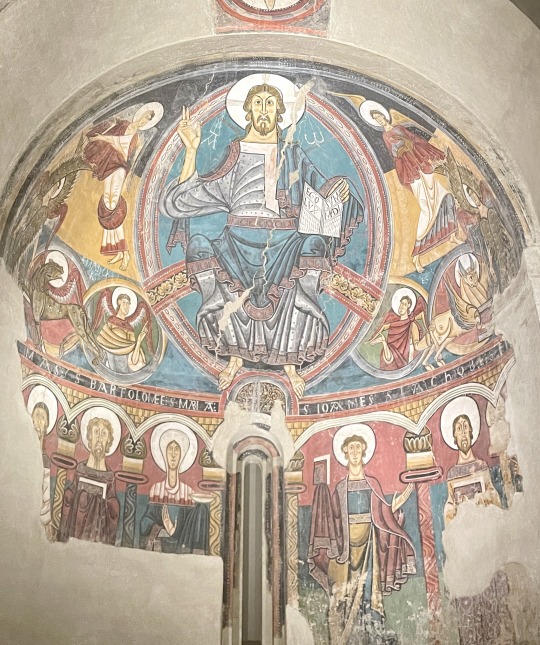
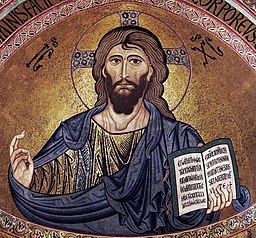


Christ in Majesty, fresco. Circa 1123. Master of Taüll. Apse of Sant Climent de Taüll Museu Nacional d'Art de Catalunya, Barcelona
Christ Pantocrator, mosaic. 1130. Cefalù Cathedral. Cefalù, Italy. 📷 Wikimedia Commons, Andreas Wahra, CC BY-SA 3.0
Christ in Judgment, tympanum, 1150. Abbey Ste Foy📷 Daniel Villafruela, CC BY-SA 3.0 via Wikimedia Commons
The Deesis mosaic, 1280. Hagia Sophia, IstanbuI, Turkey. Wikimedia Commons © JoJan, CC BY-SA 3.0
You've seen Him in frescos, mosaics, tympanum, paintings, illuminated manuscripts and more but do you know your Christ in Majesty from your Christ Pantocrator? The difference between Christ in Majesty and Christ in Judgment? What about the Christ Pantocrator and the Deesis?
Although sharing some similarities, the iconography of Christ differs between the Western Church and Eastern Orthodox Church.
The distinction comes from how both Churches interpreted the Heavenly throne described in The Book of Revelation and how those interpretations were then depicted in church architecture that developed in the East and West.
Early Christian art
Generally divided into two periods by scholars, early Christian art is bucketed into one of two camps: before and after either the Edict of Milan of 313 (whereby Christians were legally protected from persecution) or the First Council of Nicea in 325 (where Constantine I called for a meeting of all the Christian bishops to try to define Christian doctrine for all their followers around the Empire).
One of the major reasons for convening the council was major questions was around Christology. Specifically, what was the relationship between God the Son and God the Father. This concept is confusing and needed some consensus for sure (spoiler- was not figured in 325).

Regardless of the marker, once Christians were able to freely express themselves and their ideas about God in overt ways, a process began where the underground (literally in the catacombs), indirect symbols and ambiguous iconography of a persecuted people would evolve into mainstream icons for the all the world to see.
How would older symbols continue to be used? What new ones would develop? And, of course, where would Christians put them all?
Brief Christian History timeline
313 - Edict of Milan
325 - First Council of Nicea
324 - Constantine makes Byzantium the new capital of Roman Empire
330 - Byzantium becomes Constantinople
380 - Christianity becomes the state church of the Roman Empire
Late 5th century - collapse of the Western Roman Empire
Roman Empire 379-1453

Christian architecture
Christians would model their places of worship on the basilica, originally a large multi-functional public building in ancient Rome. The design of the original basilica was a rectangle shape with a longitudinal nave with an apse on one end (there could be more) and a roof with two levels, the higher roof in the middle to allow for a clerestory above.
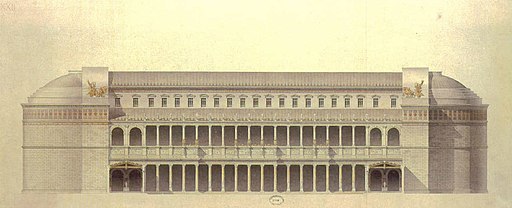
19th century reconstruction of the 2nd century AD Basilica Ulpia, part of the Trajan's Forum, Rome. Julien Guadet, prix de Rome, Public domain, via Wikimedia Commons
The basilica quickly became the template for a standardized architecture of Christian worship, the church. Specific features would Christianize for the church's needs, like the apse. In a civil basilica for example, the apse was the place where officials would congregate and where the Emperor would sit, in the Christian basilica it would become the place above the altar, where Jesus would be depicted. As time went on, the two Churches would use the space in ways that would effect the Christian art made inside.

Basilica of Sant'Apollinare in Classe near Ravenna, Italy, 6th century. Angela Rosaria, CC BY-SA 3.0, via Wikimedia Commons
Christian art
The various versions of Christ would gradually take form inside these churches, birthing the predecessors of the standardized iconography that would become the Christ in Majesty and the later Christ in Judgement and the Deesis and Christ the Pantocrator.
By the 4th, 5th and 6th centuries, the change was underway. It is as if artisans were thinking out loud on how to interpret the Old and New testaments, their images of a personified Jesus could be depicted in various ways - as a young, short haired, beardless, law giver, shepherd or even a warrior as well as bearded, long-haired and older, like the version standardized today.
Young, beardless Christ

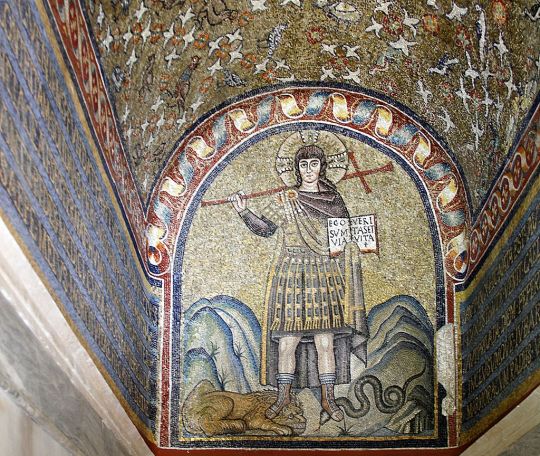
[Left] Christ the Lawgiver. Basilica of San Lorenzo, Milan, Italy. 4th century. Wikimedia Commons © Giovanni Dall'Orto
[Right] Christ treading the beasts. Chapel of Saint Andrew, Ravenna, Italy. 6th century. Wikicommons © José Luiz Bernardes Ribeiro
The mosaics above reflect important symbols and ideas of the time. In Christ the Lawgiver, Jesus is surrounded by his disciples. He is beardless, donning a golden halo. He is dressed in a white and gold toga and seated on a throne dais with his feet on a stool. His left hand holds the New Testament and raising his right hand (this right hand would have a number of meanings- from a gesture made to signal the right to speak, a gesture made by Emperors handing over a decree, to teaching gesture and finally becoming a gesture of blessing).
In Christ treading the beasts, Christ is alone, beardless, his head is surrounded by a golden four-armed cross halo. He is dressed in royal purple for battle, standing and stepping on the heads of the lion and the serpent. He is holding the Gospel with his left hand and grasping a large cross that rests on the shoulder, ready to take on any evil that may come his way.
In both cases, a young, beardless and haloed JC is taking on the appearance of a particular message the patron wants the artist to deliver to its audience.
Early Christian art was heavily influenced by Roman art and therefore the art that had influenced Rome, the art of Ancient Greece and thereby Greece's own influences - Egyptian, Mesopotamian and Persia art.
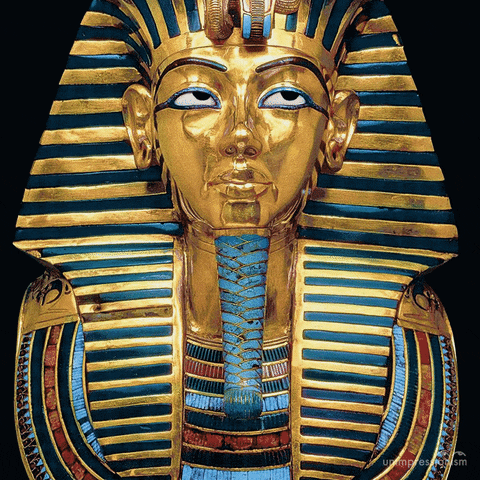
All cultures and religions take from and build upon the cultures and religions that came before them, adapting stories and visual language to suit their needs and the stories they want to tell.
If young strong Greco-Roman gods were portrayed as young and beardless, it would make sense for artists to show Christ in this way too. If deities in Ancient Egypt and Greco-Roman gods were depicted with halos/auras, Christ most certainty should too.
In the Lawgiver Christ, we see an emperor at the Forum with all other senators surrounding him. In Christ treading on beasts in Ravenna, we see a Christ in battle, triumphant against the hoards of pagan Germanic tribes to Ravenna's North or the defeat of Arianism within the Church itself.
Older, bearded Christ
The following image is said to be one of the earliest bearded Christ depictions which is now the prevailing, mainstream image we have come to know. Here Christ is fully bearded Jesus with long hair and a halo. This image emerged around 300, but it did not become established until the 6th century in the East and much later in the West.

Bust of a Bearded Christ, Catacombs of Commodilla, Rome, Italy. Late 4th Century. Wikimedia Commons, © Public Domain
Art historians point out several possible reasons why the now conventional images of Christ are bearded. Some like Paul Zanker surmise that this version is a reflection of Zeus, the King of Roman Gods and the look of the classical Roman philosophers. It would seem to me that most adult men had beards at the time. Certainly maybe, a 33 year old, Jesus probably would not have been clean shaven.
But how do we go from the above Jesus to Christ in Majesty, Christ in Judgment, Christ Pantocrator and the Deesis?
To be continued in a future post...

Sources
Depiction of Jesus
Early Christian art and architecture
Christ in Majesty
#christ in majesty#christian art#romanesque#christian iconography#art history#iconography#mosaic#architecture
0 notes
Text
Saints&Reading: Monday, June 17, 2024
june 4_june 17
SAINT MITROPHANES, FIRST PATRIARCH OF CONSTANTINOPLE (325)

Photo: Pravoslavie.ru
Saint Metrophanes, Patriarch of Constantinople, was a contemporary of Saint Constantine the Great (306-337). His father, Dometius, was a brother of the Roman emperor Probus (276-282). Seeing the falseness of the pagan religion, Dometius came to believe in Christ. During a time of terrible persecution of Christians at Rome, Saint Dometius set off to Byzantium with two of his sons, Probus and Metrophanes. They were instructed in the law of the Lord by Bishop Titus, a man of holy life. Seeing the ardent desire of Dometius to labor for the Lord, Saint Titus ordained him presbyter. After the death of Titus first Dometius (272-303) was elevated to the bishop’s throne, and thereafter his sons, Probus (303-315) and in 316 Saint Metrophanes.
The emperor Constantine once came to Byzantium, and was delighted by the beauty and comfortable setting of the city. And having seen the holiness of life and sagacity of Saint Metrophanes, the emperor took him back to Rome. Soon Constantine the Great transferred the capital from Rome to Byzantium and he brought Saint Metrophanes there. The First Ecumenical Council was convened in 325 to resolve the Arian heresy. Constantine the Great had the holy Fathers of the Council bestow upon Saint Metrophanes the title of Patriarch. Thus, the saint became the first Patriarch of Constantinople.
Saint Metrophanes was very old, and was not able to be present at the Council, and he sent in his place the chorepiscopos (vicar bishop) Alexander. At the close of the Council the emperor and the holy Fathers visited with the ailing Patriarch. At the request of the emperor, the saint named a worthy successor to himself, Bishop Alexander. He foretold that Paul (at that time a Reader) would succeed to the patriarchal throne after Alexander. He also revealed to Patriarch Alexander of Alexandria that his successor would be the archdeacon Saint Athanasius.
Saint Metrophanes reposed in the year 326, at age 117. His relics rest at Constantinople in a church dedicated to him.
It should be noted that the Canons to the Holy Trinity in the Midnight Office in the Octoechos were not composed by this Metrophanes, but by Bishop Metrophanes of Smyrna, who lived in the middle of the ninth century.
THE HOLY MARTYRS FRONTASIUS, SEVERINUS, SEVERIANUS AND SILANUS OF GAUL (1st.c)

The Holy Martyrs Frontasius, Severinus, Severian, and Silanus suffered for Christ under the emperor Claudius (41-54). They had been sent to preach the Word of God in southern Gaul (now France) by Bishop Frontonus of Petragorium. The governor, a pagan named Squiridonus, arrested them and demanded that they renounce Christ. But the martyrs firmly confessed their faith, saying they had but one desire, to either live or die for Christ. The enraged Squiridonus ordered that the saints be taken out before the city, tied to pillars, and have nails thrust into their heads like a crown of thorns. After this they were beheaded.
Tradition says that the holy martyrs continued to live by the power of God. They picked up their heads and went to the church of the Mother of God, where the holy bishop Frontonus, who had sent them preaching, was at prayer. Placing their heads at the feet of the bishop, they crossed themselves and died.
Source: Orthodox Chruch in America_OCA


ACTS 21:8-14
8 On the next day we who were Paul's companions departed and came to Caesarea, and entered the house of Philip the evangelist, who was one of the seven, and stayed with him. 9 Now this man had four virgin daughters who prophesied. 10 And as we stayed many days, a certain prophet named Agabus came down from Judea. 11 When he had come to us, he took Paul's belt, bound his own hands and feet, and said, "Thus says the Holy Spirit, 'So shall the Jews at Jerusalem bind the man who owns this belt, and deliver him into the hands of the Gentiles.' " 12 Now when we heard these things, both we and those from that place pleaded with him not to go up to Jerusalem. 13 Then Paul answered, "What do you mean by weeping and breaking my heart? For I am ready not only to be bound, but also to die at Jerusalem for the name of the Lord Jesus." 14 So when he would not be persuaded, we ceased, saying, "The will of the Lord be done."
JOHN 14:27-15:7
27 Peace I leave with you, My peace I give to you; not as the world gives do I give to you. Let not your heart be troubled, neither let it be afraid. 28 You have heard Me say to you, 'I am going away and coming back to you.' If you loved Me, you would rejoice because I said, 'I am going to the Father,' for My Father is greater than I. 29 And now I have told you before it comes, that when it does come to pass, you may believe. 30 I will no longer talk much with you, for the ruler of this world is coming, and he has nothing in Me. 31 But that the world may know that I love the Father, and as the Father gave Me commandment, so I do. Arise, let us go from here.
1 I am the true vine, and My Father is the vinedresser. 2 Every branch in Me that does not bear fruit He takes away; and every branch that bears fruit He prunes, that it may bear more fruit. 3 You are already clean because of the word which I have spoken to you. 4 Abide in Me, and I in you. As the branch cannot bear fruit of itself, unless it abides in the vine, neither can you, unless you abide in Me. 5 I am the vine, you are the branches. He who abides in Me, and I in him, bears much fruit; for without Me you can do nothing. 6 If anyone does not abide in Me, he is cast out as a branch and is withered; and they gather them and throw them into the fire, and they are burned. 7 If you abide in Me, and My words abide in you, you will ask what you desire, and it shall be done for you.
#orthodoxy#orthodoxchristianity#easternorthodoxchurch#originofchristianity#spirituality#holyscriptures#gospel#bible#wisdom#faith#saints
0 notes
Text
Events 5.11
330 – Constantine the Great dedicates the much-expanded and rebuilt city of Byzantium, changing its name to New Rome and declaring it the new capital of the Eastern Roman Empire. 973 – In the first coronation ceremony ever held for an English monarch, Edgar the Peaceful is crowned King of England, having ruled since 959 AD. His wife, Ælfthryth, is crowned queen, the first recorded coronation for a Queen of England. 1068 – Matilda of Flanders, wife of William the Conqueror, is crowned Queen of England. 1258 – Louis IX of France and James I of Aragon sign the Treaty of Corbeil, renouncing claims of feudal overlordship in one another's territories and separating the House of Barcelona from the politics of France. 1713 – Great Northern War: After losing the Battle of Helsinki to the Russians, the Swedish and Finnish troops burn the entire city, so that it would not remain intact in the hands of the Russians. 1812 – Prime Minister Spencer Perceval is assassinated by John Bellingham in the lobby of the British House of Commons. 1813 – William Lawson, Gregory Blaxland and William Wentworth discover a route across the Blue Mountains, opening up inland Australia to settlement. 1857 – Indian Rebellion of 1857: Indian rebels seize Delhi from the British. 1858 – The Minnesota Territory gains enough population to enter as the 32nd state of the United States of America; the date is annually celebrated in the state as "Statehood Day". 1880 – Seven people are killed in the Mussel Slough Tragedy, a gun battle in California. 1889 – An attack upon a U.S. Army paymaster and escort results in the theft of over $28,000 and the award of two Medals of Honor. 1894 – Four thousand Pullman Palace Car Company workers go on a wildcat strike. 1919 – Uruguay becomes a signatory to the Buenos Aires copyright treaty. 1970 – The 1970 Lubbock tornado kills 26 and causes $250 million in damage. 1985 – Fifty-six spectators die and more than 200 are injured in the Bradford City stadium fire. 1996 – After the aircraft's departure from Miami, a fire started by improperly handled chemical oxygen generators in the cargo hold of Atlanta-bound ValuJet Airlines Flight 592 causes the Douglas DC-9 to crash in the Florida Everglades, killing all 110 on board. 1997 – Deep Blue, a chess-playing supercomputer, defeats Garry Kasparov in the last game of the rematch, becoming the first computer to beat a world-champion chess player in a classic match format. 1998 – India conducts three underground atomic tests in Pokhran. 2011 – An earthquake of magnitude 5.1 hits Lorca, Spain. 2013 – Fifty-two people are killed in a bombing in Reyhanlı, Turkey. 2014 – Fifteen people are killed and 46 injured in Kinshasa, DRC, in a stampede caused by tear gas being thrown into soccer stands by police officers. 2016 – One hundred and ten people are killed in an ISIL bombing in Baghdad. 2022 – The Burmese military executes at least 37 villagers during the Mon Taing Pin massacre in Sagaing, Myanmar.
1 note
·
View note
Photo
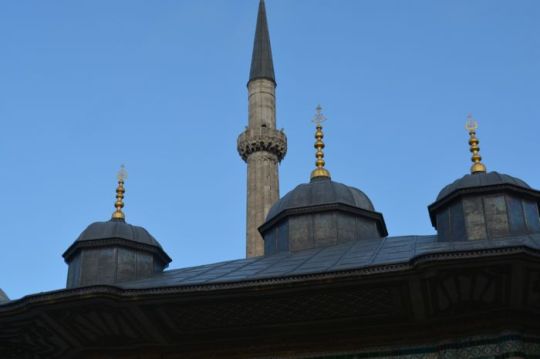
Against the Persians and Hellas
Thracian kingdoms waged wars against the Persians and Hellas for centuries. But the powerful Macedonian state of Philip II managed to crash them. It was his son, Alexander the Great, who quickly appreciated the military virtues of the Thracians and let them join the multilingual Macedonian army. After his death in 323 B. C. the Thracian king Seuth III succeeded to restore partially the former state and so the walls of the new capital city of Seuthopolis rose close to the location of present-day Bulgarian town of Kazanluk.
During the 3rd century B.C. the Romans managed to conquer the ancient Thracian lands. Later, in 74 B. C., a slave of Thracian origin who ‘graduated’ a gladiator school and became famous under the name of Spartacus headed the most continuous and mass insurrection in ancient Rome. That was the period of the so called Romanization of the Thracian world which continued until the 4th century A. D. when “The Great Migration of Peoples” began and the Thracians had to keep Celts, Huns, Goths, Avars and other barbarian tribes from invading their lands. In these circumstances the Thracians – partially Hellenized and Romanized, and having their rich and complex cultural heritage – had to stand before one of the most significant historical events for them: the disintegration of the Roman Empire in 395. In less than a century its western half was put to a collapse under the ravaging barbarian tribes from the north but the eastern part survived under the name of Byzantium with Constantinople as a capital city. Those were the days when the founders of the First Bulgarian Kingdom stepped Private Tours Balkan onto their future land…
Slavs and Proto-Bulgarians
During the 4lh to 7lh centuries the Slavs were the most multitudinous peoples in Europe.
They belonged to the Indo-European linguistic family and historians classify them usually in three main divisions: West Slavs include Poles, Czechs, Slovaks and the Wends who lived in Germany east of the river Elbe; East Slavs include Great Russians,
Little Russians (Ukrainians) and White Russians (Belorussians);
South Slavs include Serbs
Croats, Slovenes, Macedonians and Bulgarians. Originally the Slavs inhabited the lands to the north of the Carpathian Mountains but by the beginning of the 6th century Slavic tribes undertook marches to the south and crossed the Danube to loot in the territory of the Byzantine Empire. At that time a tribe of Tatar nomads, the Avars, established a kingdom (407- 653) in central Asia. In 558 they crossed the Urals and settled in Dacia after which started threatening the western countries and, of course, Constantinople. The Avars forced some of the Slavic tribes to settle permanently in various regions of the Balkan Peninsula. So were differentiated the “Bulgarian group” – which stayed in Moesia, Thrace and Macedonia – and the Serbo-Croatian group which gradually withdrew to the western half of the peninsula.
0 notes
Video
youtube
Uncovering Istanbul's Transformation Over Time
Experience the rich history of Istanbul, from its origins as Byzantium to its status as a modern-day cultural and economic hub. Explore iconic landmarks like Hagia Sophia and delve into its fascinating past as a Greek colony and center of Orthodox Christianity. Join us on a journey through time in Istanbul! Istanbul, historically known as Byzantium and later Constantinople, has a rich and varied history that spans several millennia and encompasses three major eras: Roman, Byzantine, and Ottoman. Roman Era Foundation and Early History: Byzantium: The city was originally founded as Byzantium by Greek colonists from Megara around 657 BCE. It was strategically located on the European side of the Bosporus Strait, which made it a significant trade and military hub. Roman Conquest: Byzantium came under Roman control in 196 CE after Emperor Septimius Severus besieged and captured the city. Constantine the Great and Constantinople: Foundation of Constantinople: In 330 CE, Roman Emperor Constantine the Great founded the city as Nova Roma (New Rome), but it soon became known as Constantinople, after Constantine. He aimed to create a new capital for the Roman Empire that was strategically located and better protected than Rome. Growth and Development: Constantine and his successors invested heavily in the city's infrastructure, including the construction of walls, forums, and significant buildings like the Hagia Sophia, initially built by Constantine and later expanded. Byzantine Era Height of the Byzantine Empire: Capital of the Byzantine Empire: Constantinople became the capital of the Byzantine Empire, the Eastern Roman Empire, and a center of Orthodox Christianity. Architectural and Cultural Flourishing: During the reign of Justinian I (527-565 CE), the city saw substantial architectural and cultural development. The most notable project was the reconstruction of the Hagia Sophia, which became a symbol of Byzantine architectural brilliance. Challenges and Resilience: Sieges and Invasions: Constantinople withstood multiple sieges over the centuries, including attacks by Persian, Arab, and Bulgarian forces. The city's formidable defensive walls, especially the Theodosian Walls, were crucial in repelling invaders. Fourth Crusade: In 1204, Constantinople was sacked by Crusaders during the Fourth Crusade, leading to a period of Latin rule known as the Latin Empire (1204-1261). The Byzantines recaptured the city in 1261 under Michael VIII Palaiologos. Ottoman Era Ottoman Conquest: Fall of Constantinople: On May 29, 1453, Sultan Mehmed II of the Ottoman Empire successfully captured Constantinople after a 53-day siege. This event marked the end of the Byzantine Empire and a significant shift in world history. Transformation and Development under Ottoman Rule: Renaming and Reconstruction: The city was renamed Istanbul, although the name Constantinople remained in use for many years in the West. Mehmed II initiated major reconstruction efforts, including the conversion of the Hagia Sophia into a mosque. Cultural and Economic Hub: Istanbul became the capital of the Ottoman Empire and one of the most significant cities in the world. It was a melting pot of cultures and a critical center for trade, culture, and politics. Architectural Renaissance: The Ottomans endowed the city with numerous architectural masterpieces, such as the Blue Mosque (Sultan Ahmed Mosque), Topkapi Palace, and the Suleymaniye Mosque, designed by the famed architect Mimar Sinan. Modern Era End of the Ottoman Empire: Early 20th Century: The decline of the Ottoman Empire in the late 19th and early 20th centuries culminated in its dissolution after World War I. Republic of Turkey: Following the war, the Republic of Turkey was established in 1923 by Mustafa Kemal Atatürk, and Ankara was chosen as the new capital. However, Istanbul remained Turkey's cultural and economic heart. Conclusion Istanbul's history as Byzantium, Constantinople, and Istanbul reflects its transformation from a Greek colony to a major Roman city, the heart of the Byzantine Empire, and finally a central city in the Ottoman Empire. Each era contributed layers of cultural, architectural, and historical richness that make Istanbul a unique and enduring metropolis.
0 notes